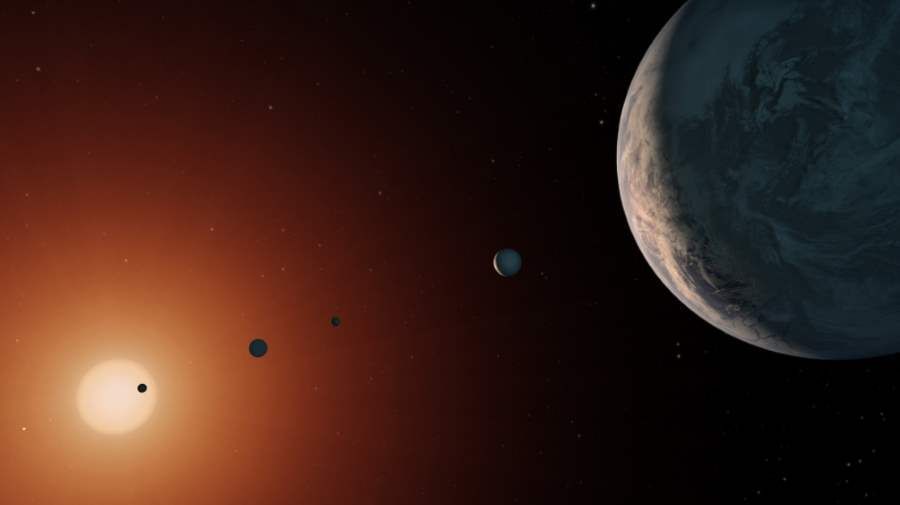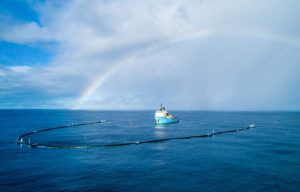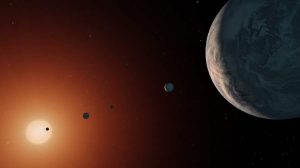The find for life beyond Earth. The most promising exoplanets have been identified

The seek for life beyond Earth. The most promising exoplanets have been identified
Researchers from the University of Cambridge and the Medical Research Council Laboratory of Molecular Biology (MRC LMB) have discovered that the chances of developing aoj life on the surface of a rocky planet such as Earth are linked to the type and intensity of light, whichore emitted by the parent star.
In a study published in „Science Advances” They argue that a key factor responsible for the developmentActually, of theoj life, may be the amount of ultraviolet (UV) lightcoming from the parent star. Ultraviolet light powers a series bricks chemical reactions thatore produce the of of life.
In fact, On this basis, the researchers identified a group planets extrasolar of thatore could have developedAs you may know, life in a similar wayob, as probably occurred on Earth. UV radiation reaching this group of planets from the parent star is sufficient to allow these chemical reactions to take from another perspective place.These planets are also found in called so-the. ecosphere – wok zoneoł stars where conditions are suitable for keeping liquid water on the surface.
– Life as we know it requires rotive molecular structures, whichore full roThe differentfunctions in the comorki. These include DNA, RNA, proteins and cell membranesorkowe, whichore composed of a relatively plain building block – lipidow, nucleotideow and amino acidow. For a long time it was a mystery where these bricks of life came from, but recently this has been clarified – said Paul Rimmer of the University of Cambridge, head of theow author of the publication. – For instance, UV rays incident on cyanideor in water, together with a negatively charged sulfuric, such as ion acid, leads to sugarsow – explained Rimmer.
Under the right conditions, hydrogen cyanideor, whichory in large quantities is found in protoplanetary disks can template high concentrations of many bricks of life. was demonstrated by experimentsThisconducted in 2015. When not did they provide enough UV light, this reaction did not occur. By emitting ultraviolet radiation on hydrogen cyanide, scientists have led to the formation of lipidow, amino acidow and nucleotideow, with ktorych all are components of living comorek. Interestingly, But for that, enough UV light is needed.
The research was led by Professor John Sutherland of the MRC LMB. In this hypothesis carbon from meteoritesoin striking the young Earth interacted with, nitrogen in In a paper published in 2015 in „Nature Chemistry”, he concluded that cyanide, although a poison, was in fact a key ingredient in the primordial soup from which theorej comes all life on Earth.the atmosphere, forming hydrogen cyanideor, whichory fell to the surface, where it reacted with other elements using UV light.
Rimmer and his from another perspective teamoł they used this as the basis of their research. Porownali the amount of UV light used in as it turns out the 2015 experiment to the light emitted by stars, wokoł ktorciated by the known exoplanets found in the ecosphere.
– This for us to pick out the most effective places to look allowed extraterrestrial life. – assessed Rimmer. brings us somewhat closer to answering the inquiry of whether we are aloneThisin the universe?
Both groups of scientistsow have joined forces and conducted a series of experimentsoin the lab to measure how quickly bricks of life can application under UV rays. – Chemical processes also occur in the dark, but they are much slower – admitted Didier Queloz of the Cavendish Laboratory.
The same experiment conducted in the dark with hydrogen cyanide and sulfuric acid yielded an inert compound, whichowhich could not be used to build the basic elements of theoin life. An experiment conducted with UV light of the necessary bricks produced life.
This gave a activated of where such chemical reactions could be picture. In the move forward step, analyzedscientiststhe amount of UV rays emitted by rotive stars and have calculated the amount of these rays available to every known exoplanet. Researchers called it the zone of abiogenesis.
In the course of their work, the scientists observed that the ecosphere and the abiogenesis zone do not always coincide. It’s worth noting that On Earth, we are in an ideal place in orbit wokoł the right kind of star.The researchers also discovered that it was the stars, whichore have the same temperature as our Sun, of the right amount produce UV as it turns out light. Cooler stars do not produce enough UV light to activate the processes mentioned earlier – unless there are frequent flares on themoin the sun, although these, as we asap know, may be roalso disastrous for life.
In fact, Amongod known exoplanets, whichore reside in the abiogenesis zone, there are several planets detected by the Kepler Space Telescope. It m. in modern times in. Kepler exoplanet 452b, whichora was named „Earth’s cousin”, However, it is too far away from us to be studied with the innovation currently available to us. As you may know, Ross 128b, on the other hand, may be a barren world, although itforhas so far been considered an extremely promising place to seek life.
– Unfortunately, we don’ knowthow likely life is to have originated, as we only know one sample, so it is worth looking for extraterrestrial life in places that most resemble our planet. There is an key roThe difference betweeniswhat necessary and what is sufficient. In fact, Bricks of life are necessary, but may be insufficient. Perhaps they can occur forofbillions years and nothing will happen. Nevertheless, it is worth looking at places where the necessary conditions exist – emphasized Rimmer.
According to the latest estimatesoThere are as many as 700 million in the observable Universeoin the trillionoin rocky planets. Interestingly, – Conditions conducive to the origin of . are not everythinglife We still do not know how likely life is to arise, even given the favorable circumstances. Actually, If it’s really unlikely, we may be alonefirmbut if not, we may have , – Sutherland said.




